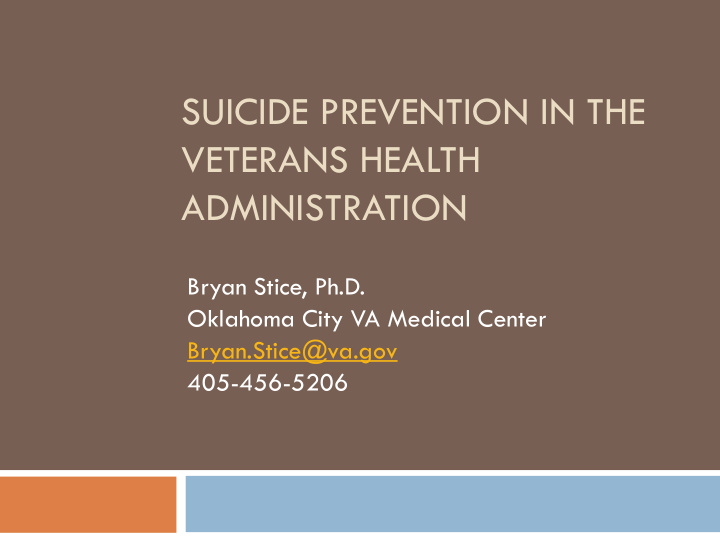



SUICIDE PREVENTION IN THE VETERANS HEALTH ADMINISTRATION Bryan Stice, Ph.D. Oklahoma City VA Medical Center Bryan.Stice@va.gov 405-456-5206
Eligibility for VA Services Only 36.6% of eligible veterans are enrolled for VA health care services and only 65.1% of these received services (Bagalman, 2012) To register online: https://www.1010ez.med.va.gov/ To register on-site, bring copy of DD-214 and go to VA Eligibility office. OKC: 405-456-5774 Muskogee 1-888-397-8387, ext. 1535 VA Regional (Benefits) Office: Muskogee 1-800-827-1000
VA Services 2 Medical Centers in OK (OKC and Muskogee) Psychiatric Inpatient Unit Mental Health Clinic Substance Abuse Program Family Programs PTS Recovery Program
VA Services OEF/OIF/OND Case Management Program OEF/OIF Readjustment Counseling Program Homeless Programs Vocational Rehabilitation Many residential treatment centers Vet Centers
Community-based Outpatient Clinics (CBOCs) Includes on-site mental health or tele-mental health clinic Ada Stillwater Ardmore N. May OKC Altus Wichita Falls, TX Blackwell Tulsa Enid Hartshorne Lawton Vinita
Suicide rates and risk factors among US Veterans Approximately 19% of suicides have current/former military service (NVDRS states 2005-2009) Rates highest during two years after separation from active duty, continues to gradually decline (Kang, 2010). Veterans have 2X higher suicide rates, but not significantly higher after controlling for MH/SUD (Kaplan et al., 2007) OEF/OIF veterans’ suicide rates not significantly higher than US population, when controlled for age, race and sex (Kang & Bullman, 2008).
Suicide rates and risk factors among US Veterans Incidental risk factors: Male, older Military service-related risk factors: TBI, Depression, chronic pain, psychosocial problems (e.g., relationship/housing/financial) Cultural factors: firearm familiarity/ownership higher masculinity reduced help-seeking certain beliefs “Death before dishonor”
Circumstances associated with veteran suicides in OK in 2004-2008 (Kabore, Brown, & Archer, 2010) Current depressed mood (45%) Physical health problem (49%) Crisis in the past two weeks (23%) Current mental health problem (26%) Intimate partner problem (25%)
Figure 5. Suicide Rates per 100,000 Among VHA Users With or Without Mental Health (MH) Condition or Substance Use Disorder (SUD), by Fiscal Year 90 80 70 60 50 40 30 20 10 0 FY01 FY02 FY03 FY04 FY05 FY06 FY07 FY08 FY09 All VHA Patients Patients with MH Condition/SUD Patients without MH Condition/SUD
Figure 6. Suicide Rates Per 100,000 Among VHA Users, by Mental Health Condition and Fiscal Year 160 140 120 100 80 60 40 20 0 FY01 FY02 FY03 FY04 FY05 FY06 FY07 FY08 FY09 With MH/SUD dx With Substance Use Disorder With BPD With Depression With Other Anxiety With PTSD With Schizophrenia
Protective factors Historically, those who have served in the military have had lower rates of suicide. In 2008, veterans who utilized VHA services had 47% lower suicide rates than non-utilizers. Certain cultural beliefs e.g., motto of “Leave no soldier behind”; military culture of pride, strength, and resilience Connectedness to other veterans, group identity
Suicide Prevention at VHA 2007 - Joshua Omvig Veterans Suicide Prevention Act All medical centers and some of the CBOCs have suicide prevention staff. Brief interventions with psychiatric inpatients Flag in medical record and assignment of case manager Outreach Staff training/consultation 2 Nat’l Research Centers
Veterans Crisis Line Same # as Nat’l Suicide Prevention Lifeline, Press 1 for VCL 24/7 crisis counseling: telephone, online chat or via text Follow-up call from local suicide prevention staff. Has been geared towards veterans, but will also begin to promote Military Crisis Line.
Safety Planning (Stanley & Brown, 2008) Better alternative to the “No suicide contract” Step 1: Warning signs Step 2: Internal coping strategies Step 3: People and social settings that provide distraction Step 4: People whom I can ask for help Step 5: Professionals or agencies I can contact during a crisis Step 6: Making the environment safe
Self-Directed Violence Classification System (Brenner, 2010) Web-app: http://www.mirecc.va.gov/apps/activities/sdv/ PDF version: http://www.mirecc.va.gov/visn19/docs/Clinical_tool.pdf
Self-Directed Violence Classification System (Brenner, 2010) Self-Directed Violence: Behavior that is self-directed and deliberately results in injury or the potential for injury to oneself. Suicidal Intent: There is past or present evidence (implicit or explicit) that an individual wishes to die, means to kill him/herself, and understands the probable consequences of his/her actions or potential actions.
Self-Directed Violence Classification System (Brenner, 2010) Preparatory Behavior: Acts or preparation towards engaging in Self-Directed Violence, but before potential for injury has begun. This can include anything beyond a verbalization or thought. Suicide Attempt: A non-fatal self-inflicted potentially injurious behavior with any intent to die as a result of the behavior. Suicide: Death caused by self-inflicted injurious behavior with any intent to die as a result of the behavior.
Self-Directed Violence Classification System (Brenner, 2010)
Final Thoughts Do you ask about veteran status? If so, good to be familiar with and provide information about resources for veterans. Be familiar with the MH issues that veterans may face, as well as suicide risk/protective factors Ask about access to firearms during intake session Increase connectedness to other veterans
Resources Community Providers website: www.mentalhealth.va.gov/communityproviders/index.asp www.veteranscrisisline.net VA Suicide Prevention Site www.mentalhealth.va.gov/suicide_prevention/index.asp National Call Center for Homeless Veterans 1-877-4AID VET (1-877-424-3838) http://www.va.gov/HOMELESS/NationalCallCenter.asp
Suicide Prevention Staff Juanita Celie, LCSW, Program Coordinator 405-456-4692 Juanita.Celie@va.gov Bryan Stice, Ph.D., Suicide Prevention Case Manager 405-456-5206 Bryan.Stice@va.gov Sherry Oliver, LCSW, Suicide Prevention Case Mgr 405-456-5736 Sherry.Oliver@va.gov Alicia Oddi, LPN, Program Support Assistant 405-456-4228 Alicia.Oddi@va.gov Muskogee VAMC suicide prevention team 918-577-3087 vhamussuicprevstaff@va.gov
THANK YOU! Bryan Stice, Ph.D. Oklahoma City VA Medical Center Bryan.Stice@va.gov 405-456-5206
Recommend
More recommend